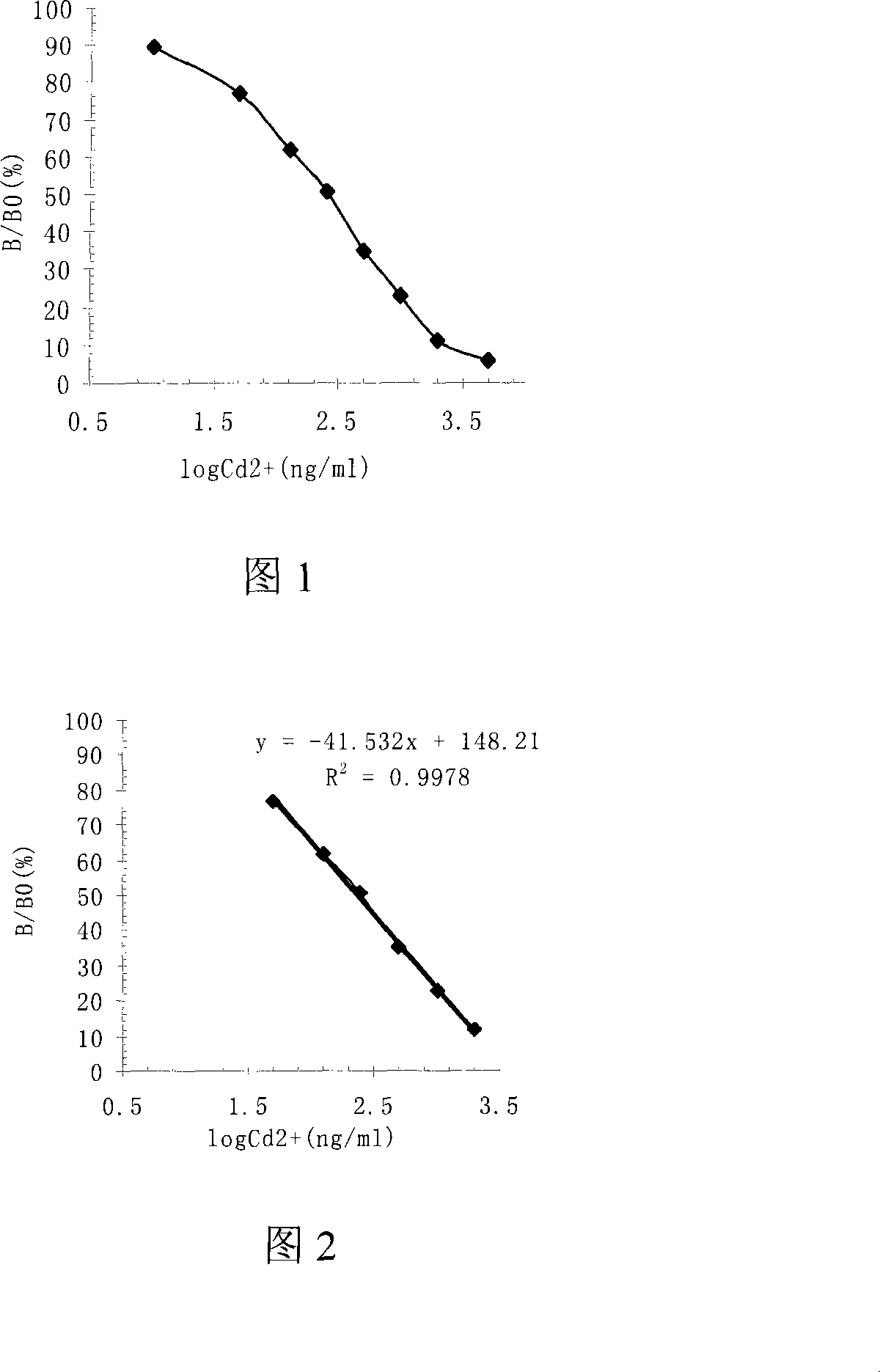Indirectly racing ELISA detecting method for cadmium ion
A detection method, the technology of cadmium ions, applied in the biological field, can solve the problems of insufficient reporting and the inability to repeatedly synthesize artificial antigens, and achieve the effect of guaranteeing interests, low cost, and sensitive detection
- Summary
- Abstract
- Description
- Claims
- Application Information
AI Technical Summary
Problems solved by technology
Method used
Image
Examples
Embodiment 1
[0035] Utilize anti-cadmium ion monoclonal antibody to detect the indirect competition ELISA method of cadmium ion, comprises the steps:
[0036] (A) Cadmium ions were coupled to hemocyanin (KLH) using iEDTA (i.e., 1-(4-isothiocyanobenzyl)ethylenediamine-N,N,N',N'-tetraacetic acid), Mix Freund's incomplete adjuvant to immunize BALB / c mice, take the splenocytes of the immunized mice and fuse them with SP2 / 0 myeloma cells, screen out positive cell lines that stably secrete anti-cadmium ion monoclonal antibody (MAb-Cd) and expand Cultured, injected cells into mice to induce ascites, and purified to obtain monoclonal antibodies against cadmium ions.
[0037] (B) Using iEDTA to couple cadmium ions to the carrier protein BSA to obtain the detection antigen Cd-iEDTA-BSA.
[0038] (C) Preparation of antigen pre-coated strips:
[0039] (1) Coating: Dilute Cd-iEDTA-BSA to 0.2 μg / mL with coating buffer (0.05M sodium carbonate buffer, pH9.6), add 100 μL per microwell into a polystyrene ...
Embodiment 2
[0061] Utilize anti-cadmium ion monoclonal antibody to detect the indirect competition ELISA method of cadmium ion, comprises the steps:
[0062] (A) Use iEDTA to couple cadmium ions to hemocyanin (KLH), mix Freund's incomplete adjuvant to immunize BALB / c mice, take splenocytes from immunized mice and fuse SP2 / 0 myeloma cells, and screen out Stable positive cell lines secreting anti-cadmium ion monoclonal antibody (MAb-Cd) were expanded and cultured, the cells were injected into mice to induce ascites, and the anti-cadmium ion monoclonal antibody was purified.
[0063] (B) Using iEDTA to couple cadmium ions to the carrier protein BSA to obtain the detection antigen Cd-iEDTA-BSA.
[0064] (C) Preparation of antigen pre-coated strips:
[0065] (1) Coating: Dilute Cd-iEDTA-BSA to 0.2 μg / mL with coating buffer (0.05M sodium carbonate buffer, pH9.6), add 100 μL per microwell to the microwell of polystyrene microwell plate Wells were coated overnight at 4°C.
[0066] (2) Washing:...
PUM
 Login to View More
Login to View More Abstract
Description
Claims
Application Information
 Login to View More
Login to View More - Generate Ideas
- Intellectual Property
- Life Sciences
- Materials
- Tech Scout
- Unparalleled Data Quality
- Higher Quality Content
- 60% Fewer Hallucinations
Browse by: Latest US Patents, China's latest patents, Technical Efficacy Thesaurus, Application Domain, Technology Topic, Popular Technical Reports.
© 2025 PatSnap. All rights reserved.Legal|Privacy policy|Modern Slavery Act Transparency Statement|Sitemap|About US| Contact US: help@patsnap.com



